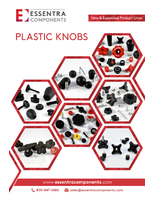Vision and Imaging Sensors / Detectors
Optical Forked Photoelectric Sensors provide label detection.
Press Release Summary:

Featuring 3 mm fork width, Models GS 61 and GS 63 are designed for detection of non-transparent labels. Model GS 61 offers removable operating head and sensitivity adjustment via teach-in function or multi-turn potentiometer. Encased in metal housing, Model GS 63 resists corrosion and has 60 mm mouth depth for accurate detection of wide labels. Auto Level Control enables sensors to automatically correct switching threshold during operation.
Original Press Release:
GS 61 & GS 63 Optical Forked Sensors
The high performance and reliability of transmitted sensing in a smaller package - the new GS 61 and GS 63 optical forked sensors
With this latest production solution from Leuze, the GS 61 and GS 63 offers more power in a smaller design, considerably improving on performance from previous models and series. This new series of optical forked photoelectric sensors are characterized by a reduced fork height, allowing for more flexibility in being placed directly at the front on the dispensing edge of a system. The core feature of these devices are greater accuracy and reliability of the entire system, with the ability to respond even faster and more directly to irregularities or errors, increasing the users end-cycle productivity.
Optical fork sensors are used for label detection in packaging and printing industries and are the most easy-to-apply and cost effective method for small part detection and counting in a wide range of industries. A cut above regular transmitted beam sensing solutions, optical fork sensors bypass many of the alignment and adjustment issues of their standard series predecessors. The new series of optical fork sensors from Leuze electronic provide accurate and reliable solutions that allow for variations in characteristics, such as detection of non-transparent labels, while maintaining high performance in a wide range of different environments.
The latest generation of forked sensors setting the bar in functionality and flexibility
The new GS 61 and GS 63 optical forked photoelectric sensors complement the successful GSU 14B and IGSU 14B ultrasonic forked sensors to create an outstanding performance portfolio. They are specially designed for the detection of non-transparent labels and, with their three millimeter wide fork widths, can be used for a wide range of applications, including the processing of booklets or folded labels.
Both devices feature a new slim line design with a flat lower fork that enables simple installation directly at the dispensing edge ideal for situations with very limited space. With very visible markings, both devices enable fast alignment of the label tape. The connection options are also designed for installation conditions with limited space and for direct mounting.
The GS 61 is the world's smallest forked photoelectric sensor for label technology in industrial quality. It features a 3 mm mouth width for exact detection of labels, and a simple sensitivity adjustment via a teach-in function or multi-turn potentiometer without the need for a tool. Also negating the need for tools is the removable operating head, so you can easily and simply adjust the parameters without the need for complex tools. With the smallest dimensions of all forked photoelectric sensors, this device is full of power and compactly packed, providing the optimum price to performance solutions for a wide range of users.
The new GS 63 is top of the class; offering first class technology that is characterized by a particularly high switching frequency and short response time, guaranteeing very good repeatability. Encased in metal housing, this device material is vastly superior to plastic in terms of protection against corrosion. Featuring the same 3 mm mouth width as the GS 61, it also features a 60 mm mouth depth that allows for accurate detection of wide labels.
The new Auto Level Control (ALC) is where the first class technology comes in to play; vastly contributing to higher performance and functional reliability. This enables the sensor to automatically correct the switching threshold during operation so that the maximum function reserve is always available through online optimization. Other innovations in this device such as storage of up to ten teach values, warning output for teach or function errors and easy adjustment via lockable teach button or teach input the GS 63 by Leuze electronic provides the best in innovation to be the best in functionality.
With its user-oriented performance characteristics, the new sensor family of optical forked photoelectric sensors sets high standards in function and flexibility.




